The outflow of prescriptions and the billion-dollar market it brings are the focus of attention.
In the communication with the industry, the arterial network found that in the huge market brought about by the outflow of prescriptions, everyone has made various pre-judgments and carried out various places and layouts.
What people are particularly concerned about is: In the new market structure, retail pharmacies, DTP pharmacies, medical e-commerce, and hospital-side stores, what are the advantages and disadvantages of each, who will become the biggest winner?
In this regard, on the basis of a large number of investigations and studies, the arterial network intends to analyze from five dimensions: prescription acquisition, drug supply support ability, and medical insurance support.
Policy + market force: the overall situation of prescription outflow has been set
Prescription flow is a prescription. It was originally completed in the hospital, prescribed, and obtained. Now it no longer restricts the free flow of prescriptions. Drugs are provided by social pharmacies, and medical treatment and drug separation.
The reason for the outflow of prescriptions is the mechanism of “breaking medicines and keeping doctorsâ€, allowing hospitals to return to the essence of medicine and weakening the “exclusiveness†of prescriptions. The policy of medical insurance control fees, zero-plus, and control of medicines is the most important driving factor for hospitals to have some prescriptions. The prescription outflow is both a “political task†and a “market regulationâ€.
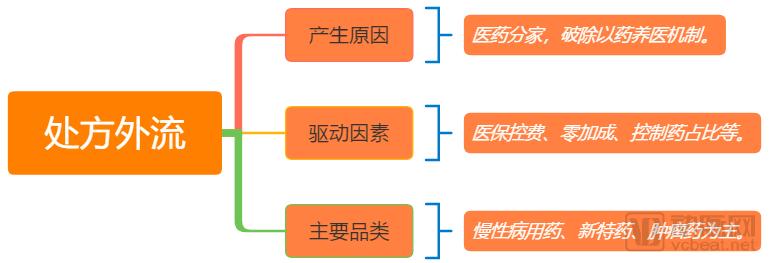
Chronic disease drugs, new special drugs, oncology drugs, etc. will become the "first batch" outflow prescriptions, which not only provide convenience for patients, especially chronically ill patients, but also control the proportion of hospital drugs and reduce the pressure on hospital pharmacies.
All the players are in match and are targeting the 100 billion market.
The outflow of prescriptions will bring about the adjustment of the structure of drug distribution channels. For the market, it is both a stock adjustment and a new growth point. Therefore, retail chain pharmacies, DTP pharmacies, hospitals, medical e-commerce, Internet + medical companies are targeting this opportunity and actively deploying.
Prescription outflow mode and major players

Chain pharmacies are most optimistic
At the moment, the main direction of policy for prescription outflows is retail pharmacies. For example, the 2016 “Medical Reform†task list indicates that hospitals are prohibited from restricting prescription outflows, and patients can choose to purchase medicines at hospital outpatient pharmacies or by prescription to retail pharmacies.
The 2017 “Medical Reform†task list pointed out that it is planned to conduct retail pharmacy grading management, encourage the development of chain pharmacies, and explore the medical institution's prescription information, medical insurance settlement information and drug retail consumption information interconnection and real-time sharing. This means that the policy has a clearer direction for how pharmacies can undertake prescription outflows, and will support retail pharmacies in taking prescription outflows in terms of prescription sources and medical insurance payments.
It is the positive trend of the policy. The leading companies such as Yixintang, Yifeng, the general public, Dashenlin, and the National Pharmacy have actively placed prescription outflows, emphasizing the improvement of professional service capabilities and preparing for prescription outflows.
For example, the general public said in the management of the board of directors that the company has actively promoted professional services such as chronic illness living museum, micro-medical consultation, customer APP, WeChat service number medication consultation, disease management, etc., to improve the pharmacist of the store, and use the employee APP to the clerk. Conduct training on illness consultation and related medications, and join an automated server to assist employees in improving their professional services in disease and drug knowledge. Prepare to take over the prescription outflow of the hospital.
The layout of other listed pharmaceutical chain leaders is similar to that of ordinary people. Starting from improving professional service capabilities, the management and operation of members are strengthened, especially for patients with chronic diseases and chronic diseases.
DTP pharmacy grows fastest
The DTP (Direct to Patient) pharmacy originated in the United States and is a specialized drug sales model. In this mode, the pharmaceutical company directly authorizes the product to the drug store agent, and the patient takes the prescription issued by the doctor and goes directly to the pharmacy to purchase the drug.
DTP pharmacies have the characteristics of “double highâ€: one is that the proportion of prescription drug sales is high, more than 90%, and basically no sales of over-the-counter drugs; the second is that the brand concentration is high, and most of the sales rankings are from large pharmaceutical companies. Anti-tumor drugs, such as Herceptin, Kemena, Xiu Mei Le, Gleevec, Teresa, and Dorjemei. In addition, most of these drugs have entered national or local health insurance. In other words, medical insurance support is also an important factor in the DTP pharmacy.
The important product structure of DTP pharmacy is a new special drug for tumors, autoimmune diseases, etc., as well as chronic disease drugs that need to be taken for a long time. From the perspective of drug supply, with China implementing anti-cancer drugs zero-tariff, innovative drug priority review and approval, etc. Policy, the supply of new special drugs will increase. From the approval of the listing to the entry into medical insurance, there is a certain time window, DTP pharmacy will become an important channel for the transition period. Even after entering the medical insurance, DTP pharmacies can continue to maintain channel advantage through medical insurance reimbursement.
At present, there are roughly four types of players in the layout of DTP pharmacies, including pharmaceutical industry enterprises, circulation enterprises, retail enterprises, Internet + pharmaceutical companies, and more scales including China Resources, Sinopharm, Shanghai Pharmaceuticals, Liuzhou Medicine, etc., such as China Resources Pharmaceutical DTP Pharmacy There are 88 companies covering more than 50 cities in China. After Shanghai Pharmaceuticals acquired Kantler's business in China, it also has more than 70 DTP pharmacies.
Main institutions of domestic DTP pharmacies
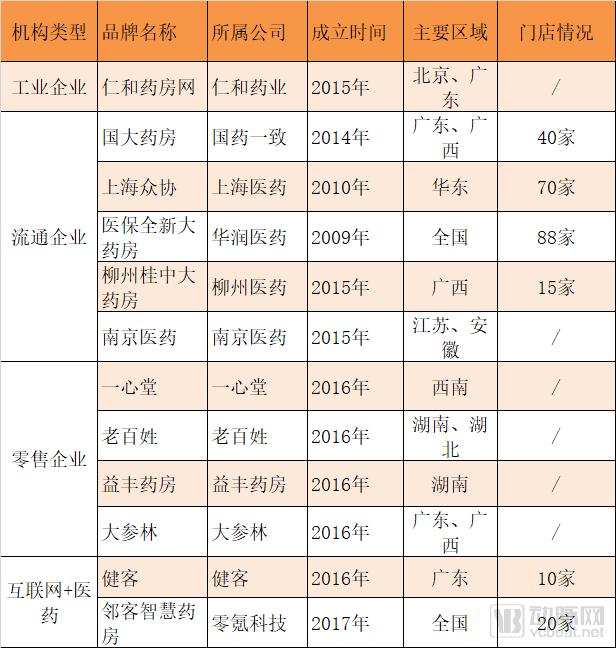
According to the annual report and public data of listed companies, the size of domestic DTP pharmacies in 2017 is about 13 billion yuan. The growth rate of DTP pharmacies is higher than the growth rate of pharmaceutical retail market. It is estimated that the scale of domestic DTP pharmacies will reach 19 billion yuan in 2020.
The courtyard shop near the water tower first month
Strictly speaking, the courtyard store is not a business format, but a description of the operating characteristics. However, many companies in the industry have emphasized this factor when undertaking prescription outflows, which is worthy of analysis.
As the name suggests, the courtyard shop is the pharmacy next to the hospital. After the patient sees the disease, he takes out the prescription and comes out of the hospital. He goes to the courtyard shop to complete the medicine.
But think carefully, the yardside store model is not simple. First of all, the location of the store is very good, the layout cost is higher than the pharmacies in the general area; secondly, the prescription shop outsourcing should also consider factors such as prescription source and drug supply support ability, especially when the entry cost is higher than ordinary. In the case of pharmacies, where does the hospitality store's return to cost and continued profitability come from?
Through observations of the main courtyard stores, we found that many courtyard stores are operated by pharmaceutical distribution companies. For example, Sinopharm and Shanghai Pharmaceuticals: By the end of 2017, Sinopharm had a total of 253 hospitals around the National Pharmacy, and 53 new ones (28 of which had medical insurance), of which 16 were profitable; as of the end of 2017, Shanghai There are 54 hospital-side pharmacies and 14 new ones. Kyushutong also cooperated with Buchang Pharmaceutical to open a nine-step pharmacy. One of the business directions is the courtyard store business.
In this way, the courtyard store is not only as simple as “the first month of the water, but the traditional drug circulation company†adapts to the trend of prescription outflow. Relying on the abundant variety reserves of the circulation company and the good connection with the hospital, the circulation business of B2B was transformed into the sales business of B2C, and the restructuring of the revenue structure was completed.
An industry veteran told the Arterial Network that the circulation company has the following advantages: First, although the medicines are separated, it is more difficult to completely cut off the interests in the short term, and there are various distribution companies and medical institutions and doctors. The contact is convenient for the treatment of various expenses; the second is that the circulation company originally has “points†for circulation business, and the price space is broader, and it has more advantages in bargaining power and profitability.
It is expected that the potential of the hospital-side store model led by circulation enterprises will be further explored in the future. The circulation enterprises represented by Sinopharm, China Resources, Shanghai Pharmaceuticals, Jiuzhoutong, etc. will actively deploy this direction and explore the circulation of medicines and equipment. More business integration points.
Medical e-commerce try "drug + medical" to create a closed loop of service
Pharmaceutical e-commerce is one of the fastest growing segments of the pharmaceutical retail industry in the past few years. After several years of rapid development, the market structure has gradually become clear, and the head enterprise echelon has emerged. A group of strength, resources and market know-how The company has formed a brand and each has obtained a corresponding market share. However, there are many variables in the medical e-commerce market, including policies, technological innovations, and model innovations.
First of all, from the policy point of view, the online sales of prescription drugs have been in an unopened state, leading to the home appliance business can only explore the move, once the policy red line is delineated, many businesses will be affected. Even the newly promulgated "Internet + medical health" policy has opened its mouth in regulation, but it has not yet released the red line of supervision. What is encouraged is the basic model of cable and the ability to form a good connection with the hospital.
From the point of view of drug safety, prescription drug online sales will remain in a restricted state for a period of time, which will bring ceiling to the expansion of medical e-commerce business and restrict the expansion of the industry.
Secondly, from the perspective of technological innovation, the core competence of e-commerce is to improve the efficiency of the supply chain, the ability to obtain traffic, and serve more users at a lower cost. These elements are all in the process of change, and technological upgrading is a spiraling path.
In order to undertake the outflow of prescriptions, we also see that pharmaceutical e-commerce companies are carrying out model innovation. For example, try the “medicine + medical†model, including cooperation with Internet hospitals, acquisition of hospitals, on-line mobile medical APP, etc. The “medicine + medical†model solves the problem of the source of medical e-commerce prescriptions, and at the same time makes users more sticky, “delineated†Users; for example, through B2B, B2C, O2O mixed business operations, to create a closed loop of business; for example, to expand to the niche market, deep service, and try to combine insurance and health management.
In summary, pharmaceutical e-commerce or online pharmacies were previously "absent" in the prescription drug market, not only the policy red line factors, but also the consumption channels and consumer behavior factors. With the recognition of Internet hospitals and remote diagnosis and treatment models, the “pharmaceutical + medical†model of medical e-commerce will become the mainstream, not only to prepare for the outflow of prescriptions, but also an important method for compliant sales of prescription drugs and market increment.
Prescription platform, Internet hospital provides support
The other two types of players involved in prescription outflows are prescription sharing platforms and Internet medical companies that provide support for prescription outflows. The prescription sharing platform refers to the establishment of information systems between drug retail institutions such as hospitals and pharmacies to open prescriptions and share prescriptions. Internet hospitals provide online doctor resources and provide electronic services for retail pharmacies, e-commerce, and O2O companies. Prescription service.
The model of the prescription sharing platform is that the patient completes the treatment in the hospital, the prescription sharing platform and the hospital system are connected to share the prescription, and the prescription information is synchronized to the patient and the pharmacy through the form of APP, WeChat, webpage, etc., and the patient can choose to take the medicine in the hospital or the pharmacy outside the hospital. .
a prescription sharing platform process
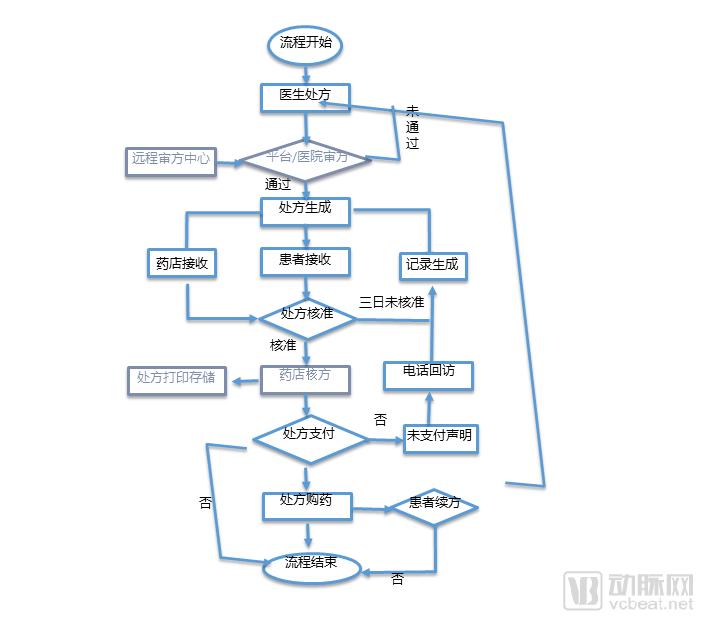
The core point of the prescription sharing platform is to ensure the authenticity, compliance, and effectiveness of the prescription information, and to eliminate the problem of fake prescriptions and multiple prescriptions for multiple prescriptions. Some companies have introduced blockchain technology into the prescription sharing platform, using blockchain technology to decentralize, traceable, and non-tamperable features to ensure the compliance of prescriptions.
Internet hospitals provide services online and are limited to referrals of common diseases and chronic diseases, and then issue electronic prescriptions as proof of purchase. This electronic prescription can be shared with medical e-commerce, medical O2O, retail pharmacies, etc.
On the basis of the Wuzhen Internet Hospital, the micro-medicine has built a “micro-medicine†segment including drug clinics and prescription sharing, and has connected the hospital information system, the retail drugstore drug distribution system and the medical insurance settlement system to realize medical treatment. Medical information sharing applications for medical insurance and medicine.
In March 2016, the micro-medicine launched the “Internet Hospital + Pharmacy Cooperation Programâ€. The cooperative pharmacy can provide accurate reservation, remote diagnosis and electronic prescription services to the members by logging into the Wuzhen Internet Hospital Pharmacy System. The pharmacy is directly upgraded to a virtual clinic. At present, the micro-medical clinic platform has access to more than 20,000 pharmacies, with an average daily service volume of nearly 50,000.
Prescription sharing platform and Internet hospital electronic prescription sharing are the auxiliary support for the industry to undertake prescription outflow. As a system builder and resource connection party, the future potential is huge.
Medicine is separated from the general trend, and the pattern of the pharmaceutical market has changed.
Since the "health reform" was launched, "medical separation" is the key content. The reason behind this is that a large part of the income of public medical institutions and personnel in China comes from medicines, and the income of medicines is compensated for the low price of medical services for a long time. The problem of “medication with medicine†is that the source is opaque, the distribution is opaque, and the supervision is not in place. It is easy to breed medical bribes, over-prescription, and high medical expenses.
The purpose of "separation of medicines" is to separate the income of medicines from the income of medical institutions, to weaken the direct interest linkage between medical bidding, medical institutions, medical personnel and pharmaceutical companies and pharmaceutical distributors, and to establish separate medical treatment and medication. The mechanism of operation.
In terms of policies, the earliest can be traced back to the "Guiding Opinions on the Reform of Urban Medicine and Health System" issued by the State Council Medical Reform Office in 2000. This opinion first pointed out that medicine should be "separately accounted for, separately managed, unified, and returned reasonably." In the following ten years, the "breaking the mechanism of taking medicine and maintaining medicine" has been repeatedly mentioned, and the policies such as controlling drug ratio, zero-plus, and prescription sharing are progressively progressed, and the separation of medicines is the general trend.
Relevant policies on "separation of medicines" in recent years
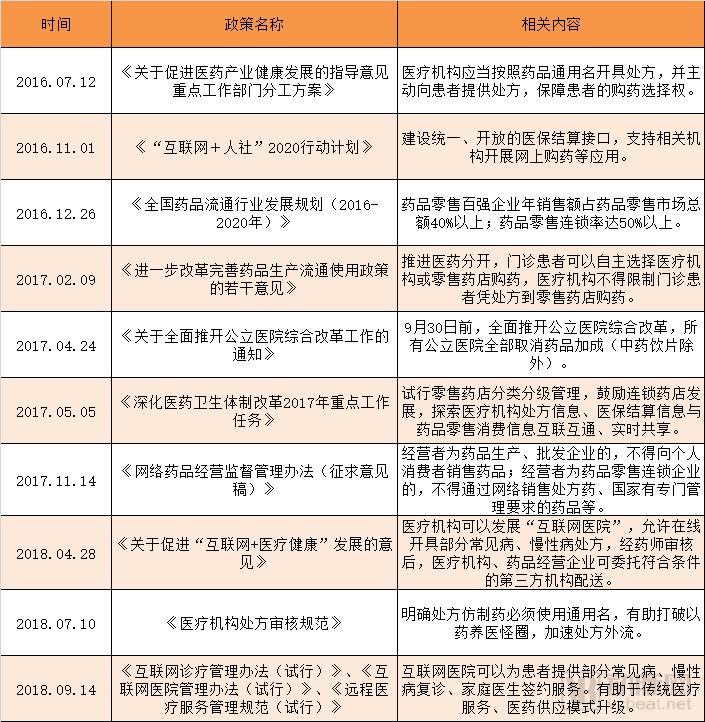
The development of "Internet + medical health" has provided new ideas for "medical reform". With the use of Internet medical treatment and remote diagnosis and treatment, it is possible to achieve the sinking of high-quality medical resources, and the supply of medicines is also planned.
In April this year, the General Office of the State Council issued the "Opinions on Promoting the Development of "Internet + Medical Health"", stating that medical institutions can develop "Internet hospitals", allowing online prescriptions for some common diseases and chronic diseases. After being reviewed by pharmacists, medical institutions, Pharmaceutical companies can entrust qualified third-party agencies to distribute.
At the beginning of July, the National Health and Health Commission, the Chinese Medicine Administration and the Logistics Support Department of the Central Military Commission jointly issued the "Regulations for the Examination of Prescriptions for Medical Institutions", clarifying that generic drugs must be used for prescription generic drugs, which would help break the cycle of medical treatment and accelerate the outflow of prescriptions.
Prescription generic drugs must use generic names to accelerate the de-branding of expired patented drugs and generic drugs. Especially after the wide range of consistency evaluations, the superimposed medical insurance payment standard will use the generic name as the payment standard, and medical institutions will give up large prescriptions. Behavior, doctors' choice of generic manufacturers has also tended to weaken, all of which help speed up prescription outflows.
In September this year, the implementation rules for Internet diagnosis and treatment management methods and Internet hospital management methods were put into use. “Internet + medical health†has become an important means to help upgrade traditional medicine and medical models.
In summary, policies such as medical insurance control fees, zero hospitalization of public hospitals, and drug-to-income restrictions have become important driving forces for prescription outflows. Chronic disease drugs and anti-tumor drugs will become the main force of prescription outflow.
The scale of prescription outflow exceeds 100 billion, who is the biggest beneficiary?
Prescription outflow is not a completely quantifiable market, so the scale of this model is difficult to have specific measurement data. There are two types of estimation methods for the scale calculation of prescription outflow: one is the channel method, according to the proportion of channels outside the hospital. The estimated size of prescription outflow is roughly estimated; the second is the ratio of medicines, because the source of outflow prescriptions is mainly hospitals, which affects the proportion of medicines in hospitals, and the proportion of hospital medicines can also be estimated.
Prescribing outflow scale

According to the above calculations, the scale of prescription outflow in 2018 is between 40-90 billion yuan. However, it is difficult to standardize the outflow of prescriptions, so the above is only a rough calculation process, which may be different from the actual situation. In addition, with the influence of graded diagnosis and treatment, and the release of primary drug use, patients in public-grade hospitals may be diverted to the grassroots level, and primary medical institutions will become important recipients of prescription outflows.
From the aspects of prescription acquisition ability, drug variety acquisition ability, pharmacy service ability, cost input, and profitability, we have scored several major prescription outflow methods, and obtained the following table:
Analysis of the main prescription outflow receiver model
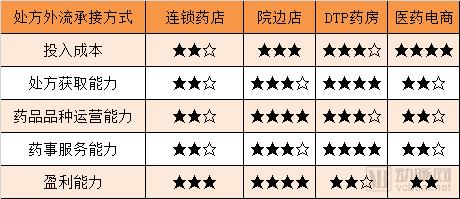
Under the trend of prescription outflow, long-term medication for new special medicines and chronic diseases will first flow out from medical institutions. Retail outlets and DTP pharmacies will become the biggest beneficiaries of prescription outflows due to the “background†and solid foundation, while chain pharmacies, Medical e-commerce, prescription sharing platforms, etc. are all good at winning the field, and there are also good development opportunities.
Prescription outflow is a systematic behavior involving medical reform, drug circulation and retail channel adjustment, business structure transformation, medical insurance policy adjustment, medical service mode change, patient willingness change and many other links, there will be a tortuous process of exploration.
Execution, “separation of medicines†also faces many challenges. The most intuitive is that after the drug income is divested from medical institutions, the benefits obtained by medical personnel are not matched with the labor pay, and there is no interest compensation mechanism.
Another problem is the acceptance of prescriptions. The drug distribution channels have long been dominated by public medical institutions. Social pharmacies still have gaps in drug supply support capabilities and drug service capabilities. Therefore, they should obtain prescriptions, ability to operate, and pharmacy services. From the perspective of ability and other angles, let the prescription outflow "flow out, can withstand", follow the medical reform and serve patients.
Collapsible Foot Spa,Foot Spa Bath Massager,Foot Bath Spa Massager,Foot Soak Tub
Huaian Mimir Electric Appliance Co., LTD , https://www.mmfootbath.com